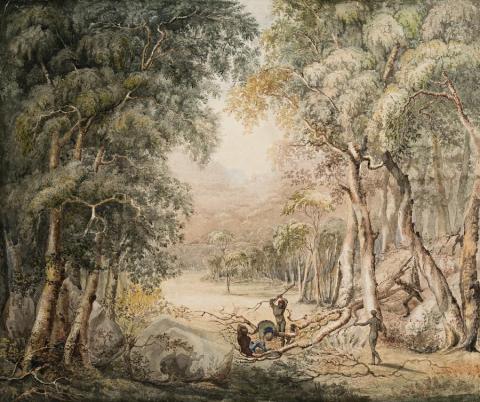(AUSTRALIAN NATIVES ATTACKING EXPLORERS DURING FLINDERS' CIRCUMNAVIGATION OF AUSTRALIA), c.1808-9
William Westall
pencil and watercolour on paper
49.5 x 59.4 cm
Spink & Son, London
Christie's, London, 16 July 1993, lot 239
Private collection, London
In 1801, at the age of nineteen, the gifted young William Westall was appointed official artist to Matthew Flinders expedition, which circumnavigated Australia in HMS Investigator during 1801-3. The scientific gentlemen on board included 'one of the greatest of all botanical draughtsmen', Ferdinand Bauer.1 Beginning at Cape Leeuwin and King George Sound in Western Australia, Westall recorded the landscape, its peoples, and exotic flora and fauna in such distant places as Port Lincoln, the Hawkesbury River and Groote Eylandt. While his direct studies are admirable in their exactness and topographical accuracy, his later watercolours and oil paintings based on them are neo-classically inclined, embellished with touches of the Picturesque, a style then in vogue in England. Moreover, he presented the Australian Aboriginal in the image of the 'Noble Savage', living in a kind of Antipodean Eden. Westall's interest in the Aborigines was such that he even recorded their cave art, the first European to do so. Generally, the expedition had good relations with the natives. Two, Boongaree and Nanbaree, accompanied Flinders on part of the circumnavigation, to help friendly intercourse with others they met. Troubles, however, were encountered in northern Australia, especially at Mud Bay, when Westall was sketching. One of their company by the name of Whitewood was speared. A native was killed, and Westall made a drawing of the body.2 Another skirmish with natives involving Westall took place at Caledon Bay in the (present) Northern Territory.
It is unlikely that this work has an exact locality. The more likely answer is that it is a 'capriccio' in an Australian setting. The trees and landscape have been given a European elegance, and the native figures have their origins more in Classical art, than in the striking realism with which Westall recorded portraits of Aboriginals from Keppel Bay to Port Jackson. The subject of the attack itself, which no doubt derives from Westall's experiences in Australia, has its in antecedents in seventeenth-century scenes of 'banditti' painted by Salvator Rosa and Gaspard Poussin. Back in London, his later oil paintings and watercolours of Australia reveal a romantic inclination in their touches of the sublime and spectacular, an engaging mixture of realism and sophisticated fantasy. This drawing nevertheless remains a work of considerable beauty and sensibility. It provides a unique view of how the country's particular individualities were seen by an early adventurer, where, to the European eye, time seemed to have stood still. Of Westall's 'wonderfully lively' drawings, Ron Radford wrote: 'They should be appreciated as extremely fine examples of the art of drawing, not just the first important historical recordings of our land. This is the prime reason we should more fully acknowledge and appreciate Westall's art.'3
1. Smith, B., Australian Painting 1788 - 1970, Oxford University Press, Melbourne, 1971, p. 8
2. Blue Mud Bay, Body of a Native shot on Morgan's Island, [1803], pencil, 15.2 x 35.0 cm, National Library of Australia, Canberra
3. Radford, R., 'William Westall and the Landscape Tradition' in Thomas, S., The Encounter, 1802, Art of the Flinders and Baudin Voyages, Art Gallery of South Australia, Adelaide, 2002, p. 114
DAVID THOMAS
